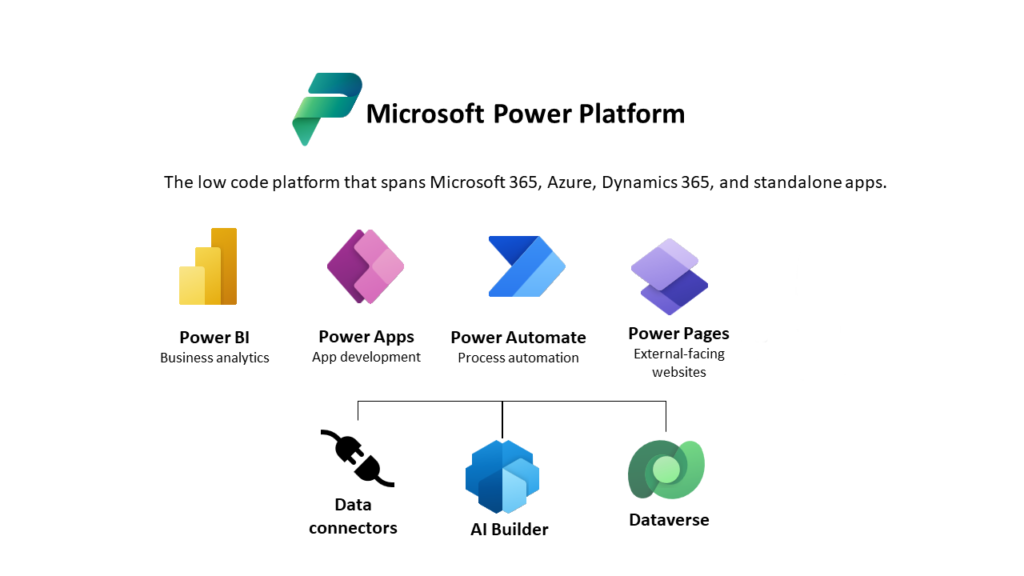
In the rapidly evolving digital landscape, businesses require agile, scalable, and integrated solutions to maintain a competitive edge. Microsoft Power Platform has emerged as a game-changer, offering a suite of tools that transcend their individual capabilities to deliver a comprehensive, end-to-end solution for modern enterprises. This blog explores how the Power Platform’s integration of Power BI, Power Apps, Power Automate, and Power Virtual Agents revolutionizes business operations and drives digital transformation.
The Core Components of Microsoft Power Platform
Before delving into the synergy between these tools, it’s essential to understand the core components of Microsoft Power Platform:
Power BI:
A powerful business analytics tool that enables users to visualize data, share insights, and make data-driven decisions.
Power Apps:
A suite for building custom apps that meet unique business needs without extensive coding knowledge.
Power Automate:
Formerly known as Microsoft Flow, this tool automates workflows across applications and services, enhancing productivity and efficiency.
Power Virtual Agents:
Allows for the creation of intelligent chatbots that can engage with customers and employees, providing automated responses and solutions.
The Power of Integration
While each component of the Power Platform is robust on its own, the true potential of this suite lies in its seamless integration. Here’s how the synergy between these tools creates a powerful ecosystem:
Unified Data Insights
Power BI integrates with Power Apps and Power Automate to provide real-time insights into business processes. For example, a custom app built with Power Apps can collect data that is instantly visualized in Power BI dashboards. Automated workflows in Power Automate can trigger data refreshes and updates in Power BI, ensuring that decision-makers always have access to the latest information.
Enhanced App Development
Power Apps leverages data from multiple sources, including Power BI and Power Automate, to build comprehensive, data-driven applications. Developers can embed Power BI reports directly into Power Apps, providing users with interactive and contextual data insights within the app itself. Additionally, Power Automate can be used to automate backend processes, such as data synchronization and notifications, further enhancing the functionality of Power Apps.
Intelligent Automation
Power Automate’s ability to create workflows that span multiple applications and services is amplified when combined with Power BI, Power Apps, and Power Virtual Agents. For instance, an automated workflow can be designed to trigger alerts in Power BI when specific data thresholds are met, send notifications via Power Apps, and engage users through a chatbot created in Power Virtual Agents. This interconnected workflow streamlines operations and reduces the need for manual intervention.
Customer and Employee Engagement
Power Virtual Agents integrate with Power Apps and Power Automate to deliver personalized and efficient interactions. Chatbots can access and update data stored in Power Apps, initiate workflows in Power Automate, and present data visualizations from Power BI. This creates a cohesive and responsive system that enhances both customer service and internal operations.
Real-World Applications
The integration of Microsoft Power Platform components has led to significant improvements across various industries:
Healthcare:
Hospitals use Power Apps to manage patient information, Power BI to monitor patient outcomes, and Power Automate to streamline administrative processes. Power Virtual Agents assist in answering patient queries and scheduling appointments.
Manufacturing:
Manufacturers employ Power Apps for inventory management, Power BI for performance analytics, and Power Automate for automated supply chain workflows. Power Virtual Agents help in troubleshooting machinery issues and providing real-time assistance to operators.
Retail:
Retailers utilize Power Apps for point-of-sale systems, Power BI for sales analytics, and Power Automate for order processing. Power Virtual Agents enhance customer service by providing instant responses to product inquiries and order tracking.
Conclusion
Microsoft Power Platform transcends its individual components by offering a unified and integrated ecosystem that drives digital transformation. By leveraging the combined power of Power BI, Power Apps, Power Automate, and Power Virtual Agents, businesses can enhance data insights, streamline processes, and improve engagement. As the digital landscape continues to evolve, the Power Platform stands out as a versatile and indispensable tool for modern enterprises.
